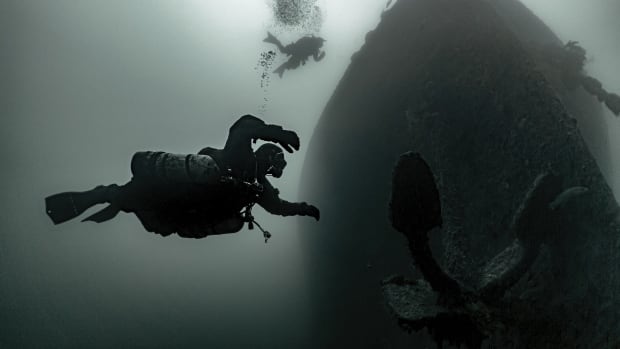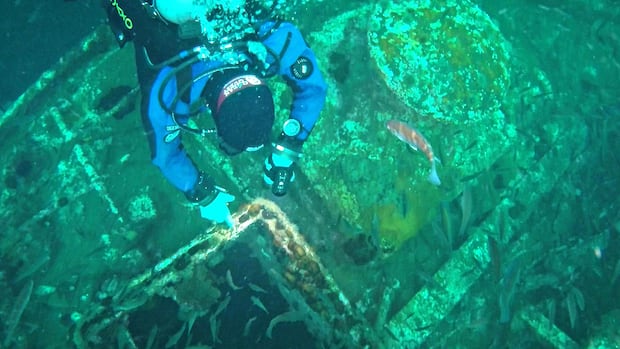It’s an unusually calm fall day on the Avalon Peninsula, and Neil Burgess and Ysabelle Hubert are preparing to take advantage of the mirror-like conditions on Conception Bay to pursue one of their passions.
The name on the side of their aluminum boat, Wreckfinder, gives it away. This married couple loves to explore shipwrecks, and on this day they’re heading to a location that attracts divers from around the world.
The four merchant steamships — all laden with valuable iron ore — that were torpedoed and sunk by German U-boats in the waters off Lance Cove, Bell Island are a sombre reminder of how the Battle of the Atlantic brought death and destruction to the waters around Newfoundland and Labrador during the Second World War.
Burgess and Hubert have made many dives to these wrecks, which lie in waters ranging from 15 to 50 metres deep, and each time they are amazed by the dramatic scenes they encounter.
On one dive, Burgess discovered a shoe, and he practically froze.
“I couldn’t help but think was somebody wearing this when the ship sank and thinking about the poor guy who was terrorized by this torpedo blowing his ship up and trying to get off with his skin. That really changed my attitude,” said Burgess.
Map illustrates the deadly toll
The Saganaga, Lord Strathcona, Rose Castle and P.L.M. 27 were sunk during two separate attacks in late 1942, a year when U-boats were brazenly sinking Allied ships at an alarming rate and threatening the supply lifeline between North America and Great Britain, the lone holdout against the Nazi onslaught. Some 65 sailors lost their lives during the attacks.
An interactive map on the Shipwreck Preservation Society of Newfoundland and Labrador’s website graphically illustrates the toll inflicted by U-boats, including the sinking of the passenger steamship Caribou, which was sailing between North Sydney and Port aux Basques when it was sunk on Oct. 14, 1942. Of the 237 on board the Caribou, 136 of them, including women and children, were lost to a torpedo fired by U-69.

U-boats often hunted in groups called wolf packs, picking off merchant ships and their naval escorts as they travelled in convoys across the Atlantic, and the society’s map proves that the waters around Newfoundland were prime hunting grounds.
“The Germans weren’t dummies,” said Burgess, who is president of the shipwreck society. “They knew to sit right where all the traffic was going to be.”
But the best known Second World War shipwrecks are in Conception Bay because of the relatively shallow water, their close proximity to shore, an active diving community and the well-preserved conditions of the wrecks.
“I got my love of shipwrecks from these four Bell Island shipwrecks,” Burgess explained.
Go beneath the waves and back in time to explore the incredible story of the German attack on Bell Island. In 1942, four merchant ships were sunk by Hitler’s U-boats, coming to a final rest on the ocean floor. Now, we’ve teamed up with historians and divers to take you on an underwater tour of the shipwrecks.
Burgess and Hubert enter the water with the full knowledge that they are visiting a war grave, and on this day, a CBC underwater drone accompanies them. There’s an explosion of marine life, including a garden of sea anemones, urchins and various species of fish. But there’s also the unmistakable outline of rusting steel, including a massive hole in the hull of one of the ships caused by an exploding torpedo.
“These guys were literally risking their lives trying to carry this iron ore over to the steel mills in Sydney to help the war effort. And here 65 of them died in the effort,” Burgess said.
Germany was a big Bell Island customer
Before the outbreak of war in 1939, Germany was one of the largest customers of iron ore from Bell Island. That ore was also a critical source of raw material for steel mills in Canada and Britain. Of course the Nazis had first-hand knowledge of Bell Island’s strategic value, and wanted to cut off that supply.

That strategy was executed with devastating effect by Hitler’s deadliest weapon in the Atlantic: marauding U-boats.
The people who lived along the shore in communities such as Lance Cove had a front row seat to the horrors of war.
What they witnessed, and their heroic response, is still talked about by their descendents, including Bell Island resident and community leader Teresita McCarthy.
McCarthy’s late father, David Kennedy, was among those who risked their lives to save panicked sailors, and recover the dead. Her late mother, Alice Lahey Kennedy, was unable to forget what she heard and saw, said McCarthy.
“She said, ‘Teresita, all I could hear was screaming and shouting and help me and save me. I’m drowning. Help me, help me,'” she said.
Family names such as Rees, Bickford, Hammond, Bennett, Kent and Kennedy loom large in the rescue and recovery effort, she explained. The Rees family home, which still exists today in Lance Cove, was transformed into an aid station and morgue during all the chaos.
“It’s impossible to forget an event that put you in the forefront in 1942 when you were a small mining community basically in the middle of Conception Bay, minding your own business,” said McCarthy, who helps run a museum on Bell Island that preserves the history of the island’s mining history, and the legacy of the shipwrecks.
Among the artifacts on display is a collection documents — including some signed by Adolf Hitler — and commendations belonging to Rolf Rüggeberg, who was in command of U-513 when the Saganaga and Strathcona were torpedoed. The items were donated by Rüggeberg’s daughter.
The decision to display the items initially raised some eyebrows, but most visitors understand, said McCarthy.
“We’re not congratulating, nor are we condemning. We are preserving the story of what happened in 1942 in the waters of Conception Bay,” she said.
Chris Power is also doing his part to preserve that history, but in his case it’s with photographs. In July, Power’s powerful and eerie images were published in a book called World War II Shipwrecks of Newfoundland: In Pictures.
Power visits the Bell Island shipwrecks between five and 10 times each year, and because of the slow deterioration of the wrecks, each dive reveals new treasures. Recently, he discovered a collection of vinyl records.
Such discoveries deepens his attachment to the shipwrecks.
“These are artifacts that people have used, touched. They meant something to somebody at one point in time. It’s a humbling experience,” he said.
Back on the water, meanwhile, Burgess and Hubert resurface after 20 minutes exploring the P.L.M. 27.
“We were on the stern, and we were in a washroom,” said Burgess. “And there was a bathtub and there was plates and broken toilet bowls.”
It’s graphic evidence that in 1942, the Germans were winning the Battle of the Atlantic, with over six millions tonnes of Allied shipping sunk that year.
Decades later, these shipwrecks are not just a popular destination for divers, but also a silent tomb to the sailors who lost their lives, and the shocked residents of Bell Island that rallied in the face of great danger.
Download our free CBC News app to sign up for push alerts for CBC Newfoundland and Labrador. Sign up for our daily headlines newsletter here. Click here to visit our landing page.



